This section contains entries about our botanizing in Baja California written for the UC BEE (Oct 2012 to Aug 2021)
and The UC Bee Hive (2022-), monthly newsletters for volunteers and staff of the UC Berkeley Botanical Garden.
Click on any photo for a larger image.
BEE JUN 2021
Playa Santa Inés
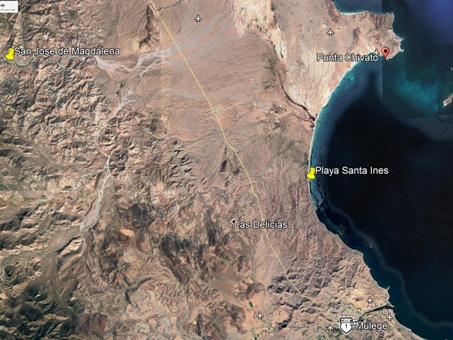 One weekend in late March, we headed to the beach, not expecting it to be the hottest day to date (92° F) nor that the water would also be too cold to swim.
One weekend in late March, we headed to the beach, not expecting it to be the hottest day to date (92° F) nor that the water would also be too cold to swim.
It was our first time to Playa Santa Inés since Spring 2019; we missed out on going in 2020 due to the pandemic and beach closures.
The Cardón cactus along the highway north out of Mulegé and on the dirt road to the beach were already showing signs of flowering. We´d seen the first open flowers around Mulegé on March 25th. Given the number of buds on this arborescent species, it looked to be a good year ahead. Otherwise, very little else was leafy, let alone in bloom. It was going to be more of the same in this drought year: gray, brown and more gray.
Image source: Google Earth 2021
Playa Santa Inés — March 2021
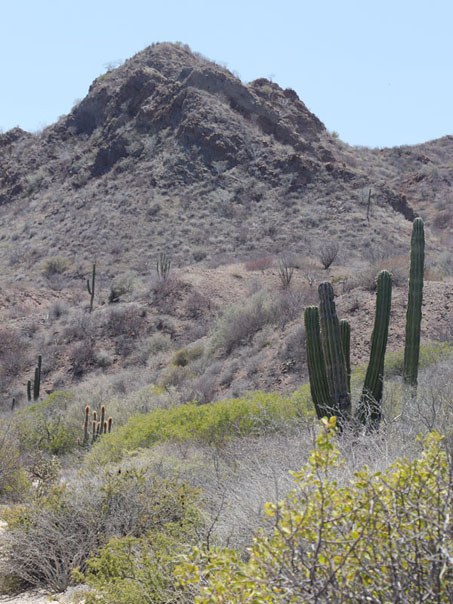
Continuing the gray theme here in the hills adjacent to the beach. The green comes mainly from Sweet Mangroves (Maytenus phyllanthoides, Celastraceae), a species that lives in damp or dry saline soils.
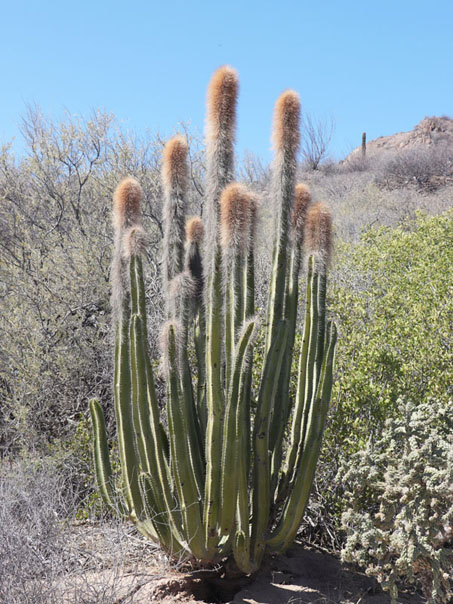
A beautiful specimen of Old-man Cactus/Garambullo (Lophocereus schottii var. schottii). This and others in the area had particularly rusty colored spines on their pseudocephalum, instead of being the usual grayish-tan.
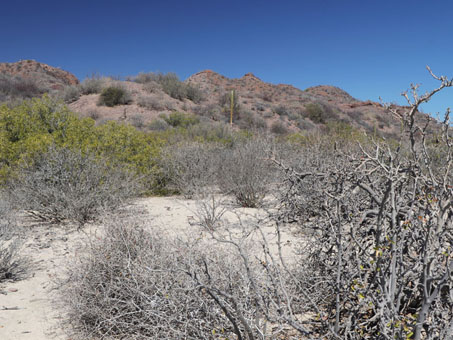
The bushes along this and other parts of the rear dunes were mostly leafless and grey. The main exception was Sweet Mangrove. See an image from a previous year of nearby dunes. Species in these gray masses include: Lomboi and Matacora (Jatropha cinerea & J. cuneata, Euphorbiaceae)...
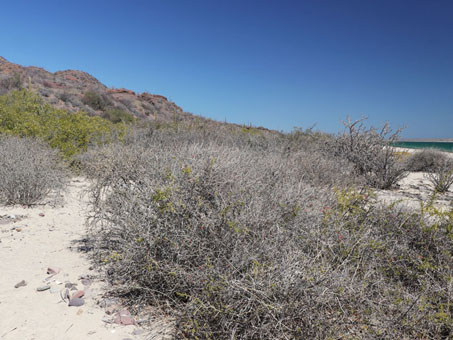
...Common Desert Thorn/Frutilla (Lycium brevipes, Solanaceae), Hummingbird Bush/Chuparrosa (Justicia californica, Acanthaceae), Southern Snakewood/Palo Negrito (Condalia globosa var. globosa, Rhamnaceae) and Guayacán (Viscainoa geniculata var. geniculata).
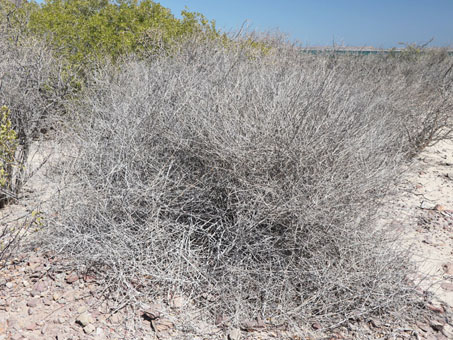
What is that large gray bush? Is it dead?
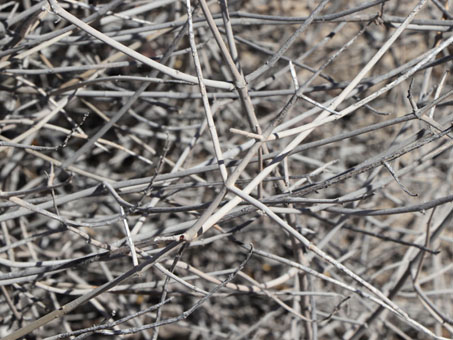
There´s life yet in the thin, tapered, canescent twigs arranged oppositely that give away its ID: Hummingbird Bush/Chuparrosa (Justicia californica, Acanthaceae).
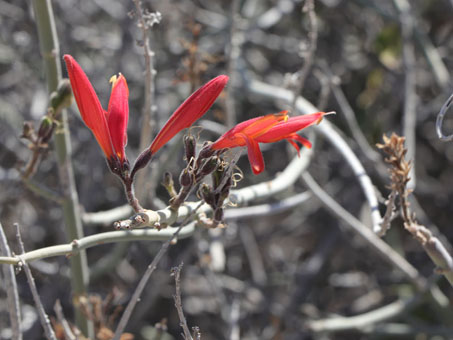
Had to look hard to find any of the Chuparrosa plants with flowers or leaves... You can see an image of this species blooming abundantly in a "wet" year. The scarlet corollas are two lipped and about 25-40 mm L.
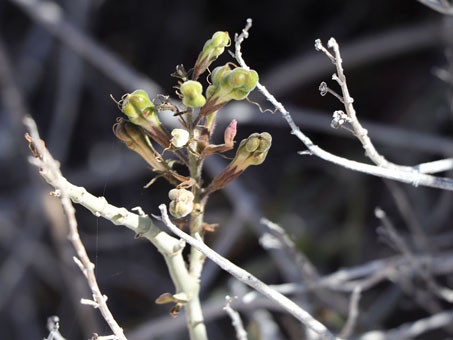
Some of the Chuparrosa even had small clusters of fruit. The little club-shaped capsules here are c. 7-8 mm D x 15 mm L.
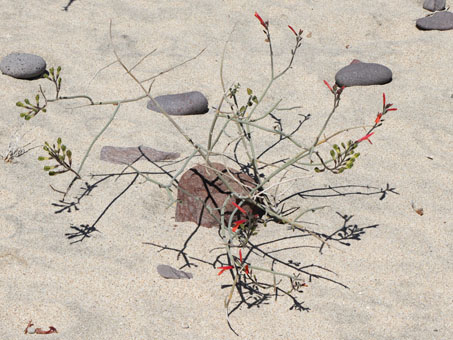
This small Chuparrosa seems to have taken seriously the open-growth approach to dune survival. Its stems were actually green compared to some of the older shrubs and it had relatively more flowers and fruit.
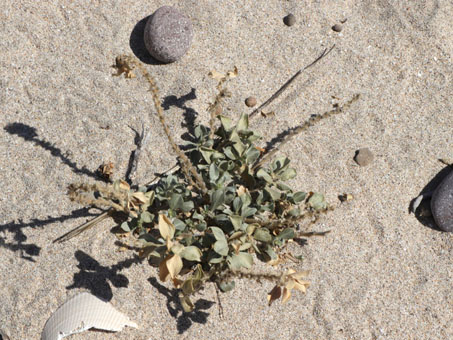
The Yuma Sandmat (Ditaxis serrata var. serrata, Euphorbiaceae) out on the open fore dunes were starting to show signs of new growth. They are densely hairy, and in our region I've only seen this species growing in the dunes. Here are flowers from a previous season.
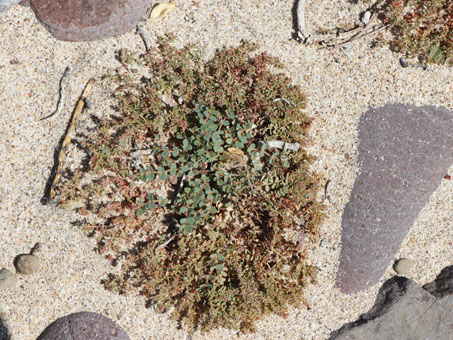
I believe this is a Small-seed Sandmat (Euphorbia polycarpa var. polycarpa). The stem and leaf posture was interesting in that compared to those plants in the nearby scrub that had a spreading open appearance and a flat leaf posture...
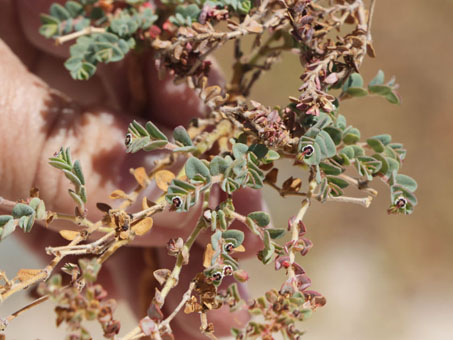
...the plants on the dunes had stems that were often ascending and tightly packed, with leaf pairs often overlapping with neighbors and folded vertically. Newer growth in the center (see previous photo) was more "normal".
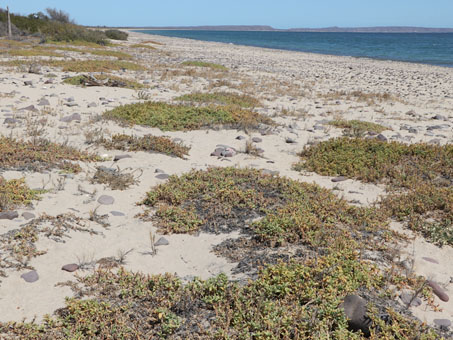
Species diversity on the fore dunes is very low. Large clusters of Shoreline Sea Purselane/Verdolaga de Playa (Sesuvium portulacastrum, Aizoaceae) can be seen here. Here's an image of the flower. Little wispy plants in between are mostly Seashore Dropseed (Sporobolus virginicus, Poaceae).
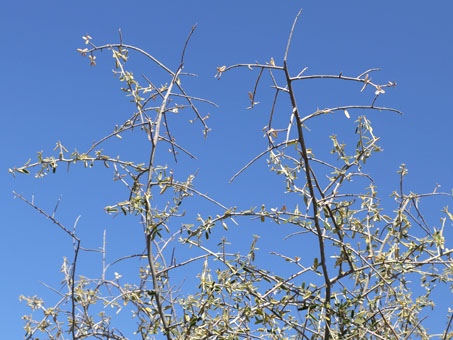
Mostly found in the rear dunes or on saline soils, Vomitbush/Juaiven (Atamisquea emarginata, Capparaceae) has an irregular, intricate growth pattern...
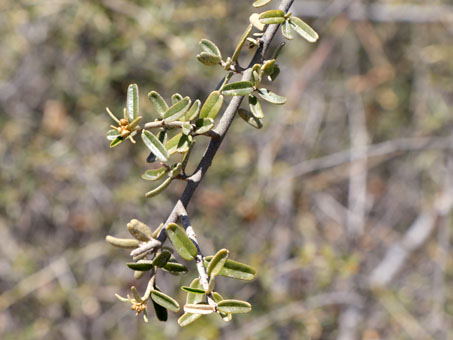
...and scaly, leathery leaves, each prominently folded.
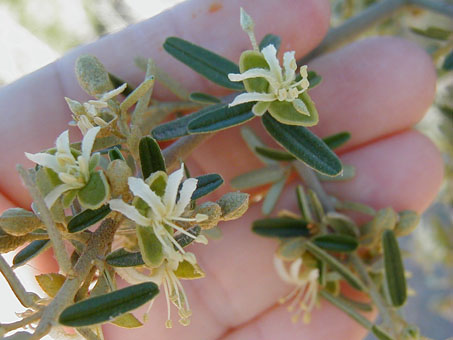
While the plants I saw on this trip were not blooming, this is a photo from another site around Mulegé from a prior year. The flowers are about 12-15 mm D and the straplike petals are furry.

A very dry east-facing rocky hillside behind the beach. Besides the Sweet Mangrove in the foreground, the only other greenery came from the Cardóns (Pachycereus pringlei, Cactaceae), here with many flower buds close to opening...
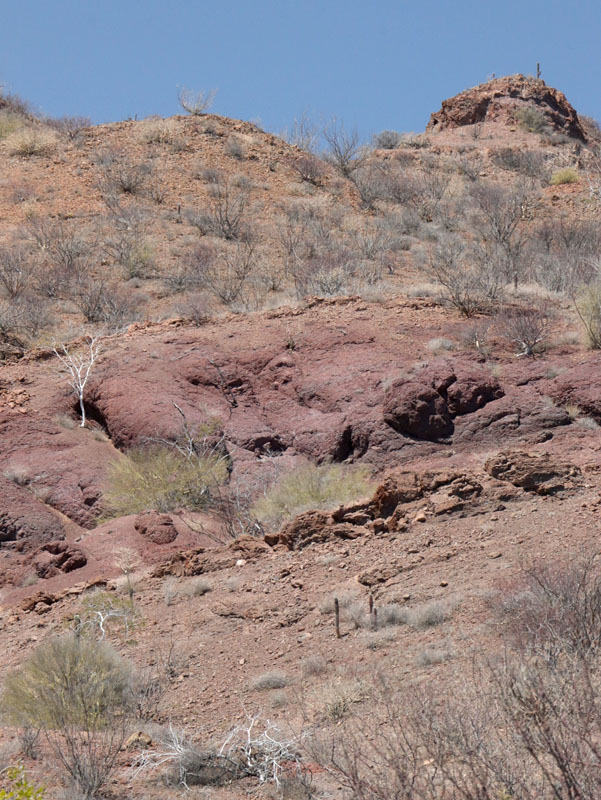
...and a few Palo Verdes (Parkinsonia microphylla, Fabaceae), their bright green branches devoid of leaves. Many of the same species growing here are also found in the rear dunes 15-20 meters away since over time, the desert scrub has been infiltrated by moving sand.
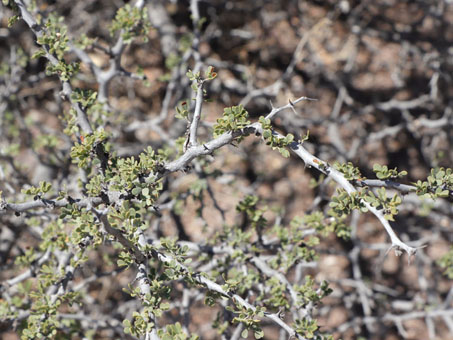
Dog Poop Bush/Ejoton (Ebenopsis confine, Fabaceae). This endemic shrub has stiff, crooked branches and sharp spines like claws...
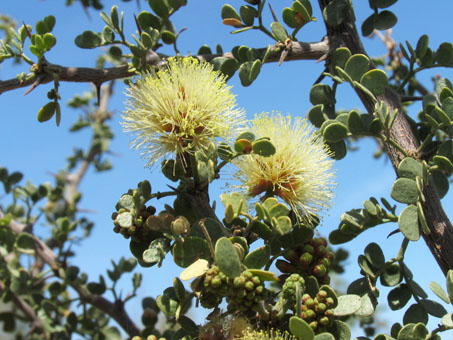
...and lovely puffballs for flowers, each about 15 mm D. The stamens pictured here are creamy-yellow on the ends and reddish at their base. (Photo from 2010).
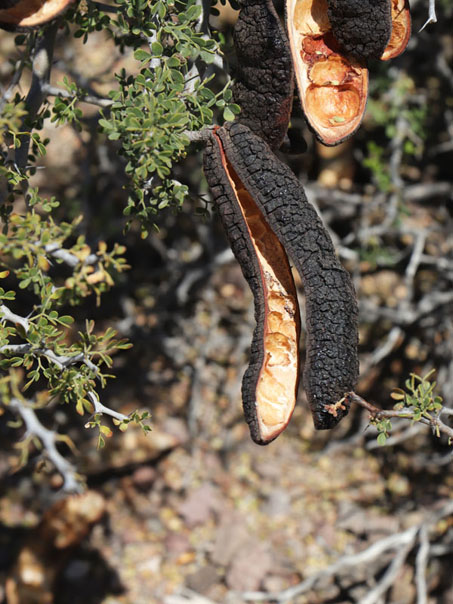
When scattered on the ground, the large (10-12 cm L), blackened, woody pods of Dog Poop Bush look like, well...you guessed it. The Spanish "Ejoton" or "large bean" is much more polite.
While many of the Cardóns were covered in buds and some open flowers, by the time we were passing them on our way home, I was not at all motivated to trek out 50-100 meters to some of the more spectacularly blooming ones in the blazing afternoon heat.
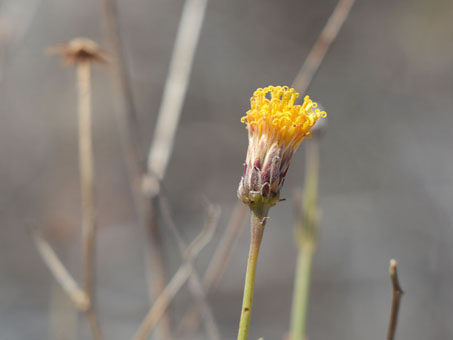
A single flower was all there was to be seen on this Sweetbush/Apán (Bebbia juncea var. juncea, Asteraceae). Neighboring plants were bare.
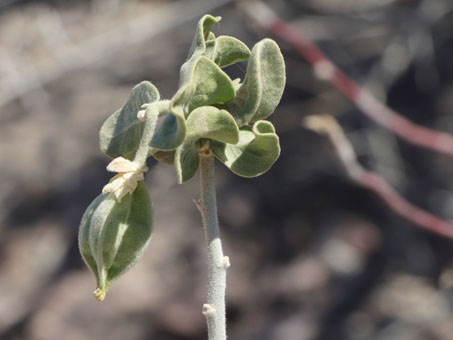
Another canescent shrub in the rear dunes: Guaycán (Viscainoa geniculata var. geniculata, Zygophyllaceae). The medium size shrub had about 20 leaves (6 or so of them here) and three of the 3-lobed fruit pictured here.
That´s it for now. Come back next month to see a bunch of interesting plants that were blooming in the northern state of Baja California on our return to the US in late April... So, until then, hasta pronto...
Debra Valov—Curatorial Volunteer
References
Rebman, J. P., J. Gibson, and K. Rich, 2016. Annotated checklist of the vascular plants of Baja California, Mexico. Proceedings of the San Diego Society of Natural History, No. 45, 15 November 2016. San Diego Natural History Museum, San Diego, CA. Full text available online.
Rebman, J. P and Roberts, N. C. (2012). Baja California Plant Field Guide. San Diego, CA: Sunbelt Publications. Descriptions and distribution.
Valov, D. (2020). An Annotated Checklist of the Vascular Plants of Mulegé, Baja California, Mexico. Madroño 67(3), 115-160, (23 December 2020). https://doi.org/10.3120/0024-9637-67.3.115
Wiggins, I. L. (1980). The Flora of Baja California. Stanford University Press. Keys and descriptions.

























